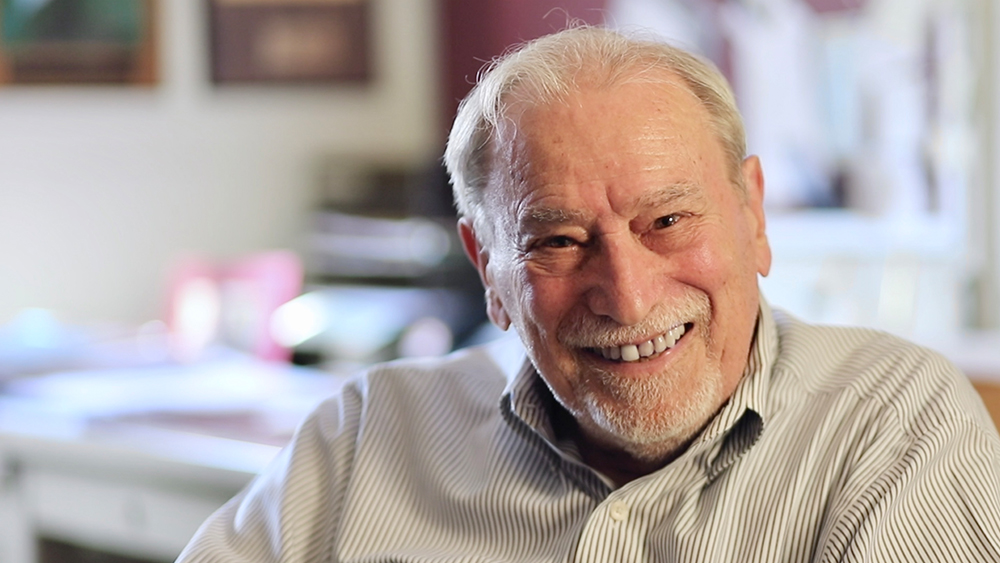
Tucked away in a quiet corner on the second floor of the Chemistry Building at Texas A&M University, Dr. Abraham Clearfield's office is blanketed with research papers old and new. Personal items naturally mingle with beakers, scientific posters and the trove of professional accolades that line the walls.
The Distinguished Professor retired in spring 2019 from the Department of Chemistry after 43 years of service to the university.
It was a toy chemistry set he received as a child that catalyzed Clearfield’s laser-focused journey to become a chemist.
He earned both his bachelor’s and master’s degrees in chemistry from Temple University. With encouragement from his wife, Ruth, Clearfield completed his doctoral degree at Rutgers University and began his career in crystallography, investigating the structure and properties of crystals.
In 1976, Clearfield accepted an opportunity to work at Texas A&M with Dr. Frank Albert Cotton, an old classmate from Temple University. Soon after, he was able to build a major X-ray diffraction laboratory at Texas A&M.
In 1986, Clearfield and a group of like-minded colleagues formed the Faculty of Materials Science and Engineering to address a growing interest in materials research, which served as the seed first for the interdisciplinary graduate program in materials science and engineering and then the department.
I told them that you’re making a big mistake if you don’t have a materials science program at Texas A&M because it’s the future. And apparently, some people heard that and they were willing to start in a small way.
“I told them that you’re making a big mistake if you don’t have a materials science program at Texas A&M because it’s the future,” said Clearfield. “And apparently, some people heard that and they were willing to start in a small way.”
The university secured a grant from the National Science Foundation (NSF) and, under the guidance of Clearfield, renovated parts of Doherty Hall and the Chemistry Building to support the new materials science and engineering activities.
Additional NSF funding in 1994 made possible the purchase of a scanning tunneling microscope, susceptometer-magnetometer and laser ablation system to further enhance the materials research.
In 2003, an interdisciplinary graduate program in materials science and engineering was approved and, in the fall 2004, the first cohort of students entered the program.
Ten years later the Department of Materials Science and Engineering was established.
It was the seed that Professor Clearfield planted at that time and his continuous support that took us where we are today.
“It was the seed that Professor Clearfield planted at that time and his continuous support that took us where we are today,” said Dr. Ibrahim Karaman, Chevron Professor I and head of the Department of Materials Science and Engineering at Texas A&M.
In fall 2018, the department enrolled its first undergraduate cohort. As the program continues to grow, the legacy of Dr. Abraham Clearfield is widely apparent.
“Materials science is going to grow and how it grows is going to depend on the students we are training now,” Clearfield said.
From the very beginning, Clearfield recognized the importance of materials research in the field of engineering. With a very clear vision, Clearfield helped set in motion the very founding of the department. Though now retired, this unwavering commitment to the university and field of materials science and engineering continues to inspire the next generation of engineers.
In spring 2018, the Professor Abraham Clearfield Materials Science Scholarship was established, which honors Clearfield for his role in starting materials science and engineering education and research efforts at Texas A&M. The scholarship supports outstanding undergraduate and graduate students pursuing a doctoral degree in the Department of Materials Science and Engineering.
“Something that is real and going to do something for the people in the program is what I was after,” said Clearfield. “And I hope to see students that come out of materials science and do some great things. This is my contribution to Texas A&M.”
In addition
Complimenting his achievements at Texas A&M, Clearfield also served on several boards and committees, including: chairman of the Synchrotron Radiation Special Interest Group (1995-96), secretary and treasurer of U.S. National Committee for Crystallography (1995-97), vice president and president of the American Ceramic Society (1998-1999) and chairman of the X-ray Powder Special Interest Group (2004).